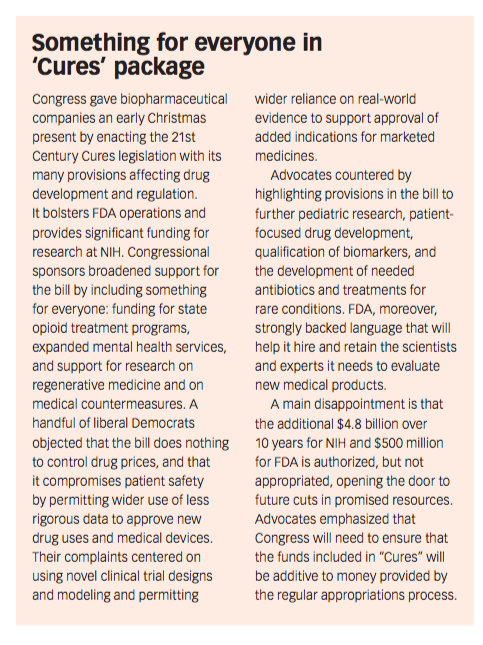'Cures' Challenges and Communication Changes Ahead
Health reform, pricing pressures will shape drug marketing and development in 2017.
As new faces and agendas emerge in Washington, pharmaceutical companies will face multiple challenges in developing safe and effective therapies that are affordable to patients and payers alike. More biosimilars, cellular and gene therapies, complex dosage forms, vaccines and combination therapies will benefit from innovative research and regulatory approaches. And the imperative of combating the devastating
Jill Wechsler

opioid epidemic across America will require formulations able to treat pain while also resisting abuse and misuse, and also put the spotlight on the role of marketers in promoting opioid prescribing.
These issues will be shaped by a new administration that has pledged to overhaul the nation’s healthcare system. The prospect of millions losing coverage has dire implications for drug prescribing and reimbursement, and for maintaining an effective drug regulatory and oversight program. Conservatives in Congress and the White House are looking to scale back federal government operations through budget cuts and hiring freezes. Such actions could be devastating for biomedical research at the National Institutes of Health (NIH) and for FDA, which already lacks sufficient resources to carry out its many mandated responsibilities and struggles to fill some 700 open staff positions.
Pharma companies could gain from corporate tax reform under Trump that lowers rates and facilitates repatriation of foreign revenues to US-based companies. At the same time, Trump’s rejection of the Trans- Pacific Partnership (TPP) trade deal undermines prospects for global harmonization of patent policies and for common standards for conducting clinical trials, producing quality medicines, and ensuring adherence to ethical and legal standards.
While industry hopes to avoid an all-out anti-pharma campaign from the new administration, pharma was jolted last month by Trump reiterating his promise to “bring down drug prices.” Continuing public outrage over too-costly medicines has prompted some pharma CEOs to pledge limits on annual price hikes. They’re also blaming price increases on the need to pay ever-higher rebates and fees to pharmacy benefit managers (PBMs) and wholesalers and calling for greater transparency in how the current distribution process limits manufacturer revenues and harms consumers who lack adequate insurance coverage.
Marketing flexibility
At the same time, a de-regulatory approach that challenges FDA restrictions on industry communications and promotional activities could lead to important policy changes for marketers. In response to legal challenges on several fronts, FDA held a public hearing in November to discuss proposals for revising policies that limit the dissemination of off-label information. Biopharma companies cited the benefits of discussing additional uses of medicines with health professionals, while FDA officials and consumer advocates raised concerns about permitting wider promotion of unproven claims.
Marketers also hope FDA will revisit its regulatory approach to social media communications and current curbs on how companies may respond to queries about unapproved uses at public meetings and through online postings. An early win could come from clarification of FDA policies for disseminating

economic information on products to health plans and formulary committees. A more flexible approach was originally proposed in section 114 of the 1997 FDAMA user fee legislation, but never implemented; language in the the 21st Century Cures legislation supports such action (see sidebar).
Trump reformers also could back changes in the Open Payments program that scale back requirements for reporting pharma payments to doctors and hospitals. Critics killed a provision in the Cures bill that dropped reporting on the value of reprints and fees paid physicians for continuing medical education activities; industry ‘Cures’ Challenges and Communications Changes Ahead for Pharma Health reform, pricing pressures will shape drug marketing and development in 2017 and CME providers will press further for that revision and other changes in the “Sunshine” program.
Innovation & evidence
A main theme of Congressional reformers is for FDA and industry to facilitate faster patient access to new therapies, a goal championed by multiple Cures provisions. But regulators can only approve those applications that sponsors submit, and that has slowed down. As 2016 came to a close, FDA official reported that new drug approvals for the year would fall far short of the near-record set in 2015. Very disappointing is the recent failure of clinical studies for a promising Alzheimer’s disease treatment and patient deaths that shut down clinical trials for a new cancer therapy.
These developments raise questions about how much data and what kind of evidence is needed to bring innovative product s to market. FDA has approved

numerous breakthrough therapies for cancer and critical conditions based on limited but convincing clinical data, increasingly with input from knowledgeable patient advocates willing to assume added risk. But the agency fears that pressure for speedy approvals despite safety signals and uncertain efficacy could undermine the regulatory process more broadly.
The issue came to a head in the recent debate over approval of Sarepta’s treatment for Duchenne muscular dystrophy. FDA reviewers found the clinical evidence too slim to support approval, but families of ill children saw benefits from the drug and pressed hard for access. Similar questions have emerged related to authorizing a new antibiotic that promises to address growing resistance, but has presented serious safety issues in clinical trials.
FDA officials also are concerned about the proliferation of priority review vouchers. While these may encourage industry investment in medicines with limited financial return, reviewers fear the program will undermine and overburden drug review operations.
Added pressure to scale back oversight of drug safety and efficacy raise the risk that key. FDA officials will depart and leave these challenges to others, as seen in the recent retirement of John Jenkins, long-time head of FDA’s drug approval office and widely praised as fair-minded and dedicated to public service. His skill in explaining the complex issues related to difficult regulatory decisions will be sorely missed.
Jill Wechsler is Pharmaceutical Executive’s Washington correspondent. She can be reached at jillwechsler7@gmail.com

FDA Outlines Updated Requirement for Placebo-Controlled Trials in Vaccine Research
May 21st 2025In an article recently published by The New England Journal of Medicine, FDA higher-ups Vinay Prasad, MD, MPH; and Martin A. Makary, MD, MPH, wrote that any new COVID-19 vaccine must now be evaluated in placebo-controlled studies.
Navigating Distrust: Pharma in the Age of Social Media
February 18th 2025Ian Baer, Founder and CEO of Sooth, discusses how the growing distrust in social media will impact industry marketing strategies and the relationships between pharmaceutical companies and the patients they aim to serve. He also explains dark social, how to combat misinformation, closing the trust gap, and more.